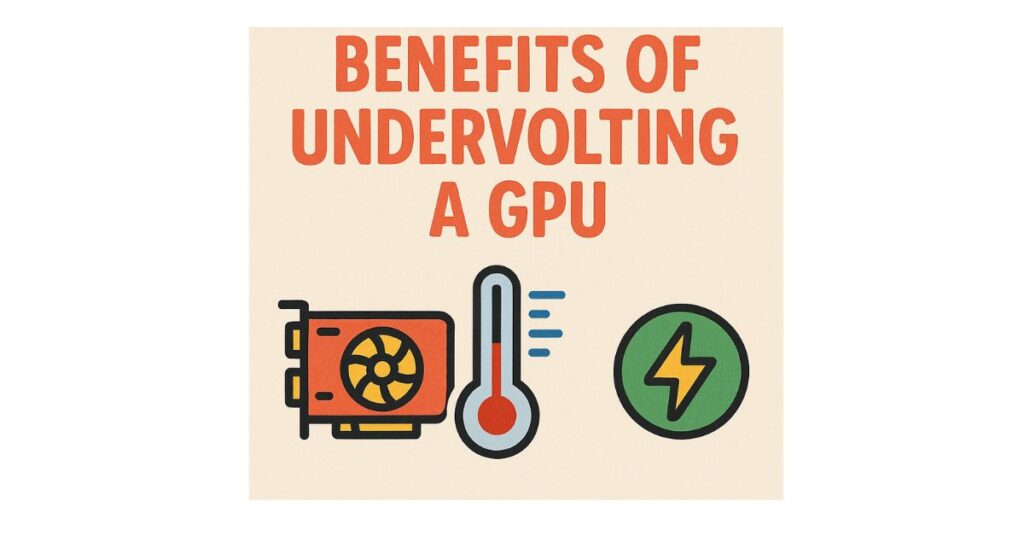Undervolting a GPU means giving it less power to run. This helps your graphics card stay cooler, use less electricity, and work more quietly, without hurting performance. It also makes your GPU last longer and stay stable.
In this guide, you’ll learn what undervolting does — and why it matters for every PC user.
Introduction
Graphics cards use lots of power and produce too much heat. But you can fix that with undervolting. It gives the GPU less voltage but keeps performance strong. It’s not magic — it’s a smart, simple way to cool things down..
Basics of GPU Power Consumption
Before diving into undervolting, let’s get one thing clear: your GPU is like a sports car. It performs great, but guzzles power and throws off heat. That energy comes in the form of voltage, and the more demanding the task (like gaming or rendering), the more juice it needs.
But here’s the kicker — most GPUs are shipped with a generous buffer of voltage to guarantee stability in every condition. That means your GPU might be running with more power than it needs.
What Exactly Is Undervolting?
Undervolting is the process of reducing the voltage supplied to your GPU without compromising its performance. Think of it like telling your car to run more efficiently with better fuel tuning.
- Undervolting ≠ Underclocking: You’re not slowing it down; you’re just making it use energy smarter.
- Undervolting ≠ Overclocking: You’re not pushing it to the edge; you’re optimizing it.
Benefits of Undervolting a GPU

You might be wondering, “Why should I even bother?” The benefits are impressive.
Lower Temperatures
When you undervolt, your GPU naturally generates less heat. Less voltage = less energy used = less heat created. Some users report temperature drops of 10°C to 20°C, depending on the GPU model and workload.
Reduced Power Consumption
If you’re conscious about electricity bills or running your rig on a budget PSU, undervolting can make a noticeable difference. Especially on laptops, where battery life is king, undervolting gives you more time away from the charger.
Less Fan Noise
Cooler components mean fans don’t need to work as hard. This results in a significantly quieter system — a bonus for streamers, editors, and gamers who hate that roaring jet engine sound.
Increased Longevity of the GPU
Running cooler and with less electrical stress, your GPU will likely last longer. Over time, high voltage can degrade GPU components, so undervolting is a solid longevity hack.
Performance Impact — Myth vs. Reality
You might think reducing voltage = reducing performance. But in most cases, there’s zero difference — or sometimes even improved performance, thanks to better thermal efficiency.
Games and Workloads After Undervolting
For modern GPUs, undervolting is pretty safe and stable. Users have reported running demanding titles like Cyberpunk 2077, Call of Duty, and rendering software like Blender with zero drops in FPS or crashes, as long as the undervolt is done correctly.
Risks and Downsides of Undervolting
It’s not all sunshine and cool breezes.
- Crashes: If you undervolt too far, your GPU may crash or freeze under load.
- Trial and Error: It may take a few attempts to find the sweet spot.
- Software Limits: Not all tools are created equal; some may not support your GPU.
How to Undervolt a GPU

Ready to give it a shot? Here’s how:
Undervolting with MSI Afterburner (NVIDIA or AMD)
- Open MSI Afterburner
- Press Ctrl + F to open the voltage curve editor
- Drag down the voltage curve to reduce the voltage at desired frequencies
- Apply changes and test with a stress tool like FurMark or Heaven Benchmark
Using AMD Radeon Software
- Open AMD Radeon Settings
- Go to Performance > Tuning
- Enable custom tuning and set Manual Voltage
- Reduce voltage (usually by 50-100mV)
- Run a benchmark or game to test stability
Best Practices Before You Start
- Backup original settings
- Use hardware monitoring tools (like HWMonitor, GPU-Z)
- Test with stress tools (FurMark, 3DMark, Unigine Heaven)
- Adjust slowly, in small steps
- Don’t rush — patience pays off
Who Should Consider Undervolting?
- Gamers who want a quieter, cooler rig
- Laptop users looking for longer battery life
- Creators/editors needing stable thermal output for long sessions
- Eco-conscious users wanting a lower power draw
Real User Experiences
One Redditor with an RTX 3070 saw temperatures drop from 78°C to 63°C and cut their fan noise in half. An AMD user shaved 15 watts off their RX 6700 XT’s draw without touching performance. These are real improvements from a simple tweak.
FAQ’s
1. Is Undervolting Safe For All GPUs?
Yes. Undervolting is generally safe for most modern GPUs when done carefully. Always test stability and reduce voltage in small steps. Crashes can happen if you push it too far, but they don’t damage hardware — just revert settings and try again.
2. Can Undervolting Improve Gaming Performance?
Yes and no. Undervolting does not directly boost FPS, but it improves thermal efficiency. This can prevent thermal throttling, keeping your GPU at top speed longer — which may lead to smoother gameplay in long sessions.
3. Does Undervolting Lower GPU Heat?
Yes. Lower voltage means less power is used, which reduces heat output. Some users report a 10–20°C temperature drop after undervolting.
4. Does It Affect Game Performance?
No. In most cases, performance stays the same — or improves slightly if thermal throttling is reduced. Proper testing is key.
5. Will Undervolting Damage My GPU?
No. If done right, undervolting does not harm your GPU. In fact, it can help extend its life by lowering heat and stress on the hardware.
Conclusion
Undervolting a GPU is a smart, safe way to lower heat, reduce noise, and save power — without losing performance. It’s great for gamers, creators, and laptop users who want cooler, longer-lasting hardware. With proper steps and testing, anyone can undervolt and enjoy a quieter, more efficient system that performs just as well, or even better, over time.
Is 80c Safe For GPU – Check It Now
